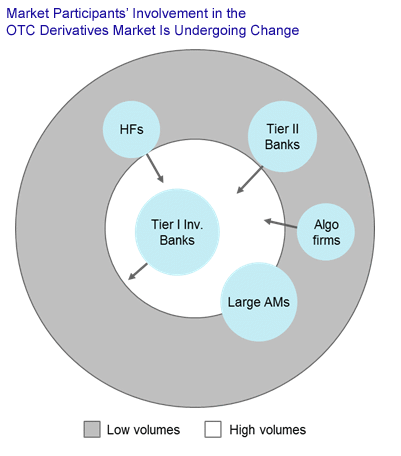Swap Execution Facilities: Market Evolution and Regulation
Abstract
The trading in swap execution facilities (SEFs) has been going on since October 2013 and is growing. Most of the large and medium-size sell side and buy side firms have been upgrading their trading infrastructure and improving their connectivity to SEFs, clearinghouses, and other third party service providers to prepare for the new multilateral trading environment.
In the report Swap Execution Facilities: Market Evolution and Regulation, Celent analyzes the introduction of the SEFs and their impact on the OTC derivatives markets. On the sell side, risk-taking capabilities are on the decline. The financial crisis and regulatory pressures have meant that sell side firms have had to cut back on their trading infrastructure. The buy side firms have not fared much better. Some hedge funds have benefited from the influx of highly skilled sell side traders, but many buy side firms are struggling to build the infrastructure required for trading on SEFs.
Investment banks are no longer following a risk-taking model. A number of key personnel have exited these organizations and joined or started hedge funds, with the result that they no longer have the same proprietary trading and risk-taking capabilities. Hence, banks are beginning to adopt an agency model where they enable market participants. This could mean that there is an opportunity for second tier sell side and larger buy side firms to trade higher volumes and dominate the market.

“A many-to-many market under the SEF regime could make for a more even playing field,” says Dr. Anshuman Jaswal, Senior Analyst with Celent’s Institutional Securities & Investments Group and author of the report. “There is an opportunity for some midsize brokers to play a more important role in the OTC derivatives space.”
The report looks at the changing role of the various market participants. It considers the move toward an agency model and how this could impact the sell side and market as a whole. We also look at some of the various risk management issues, with a focus on the concerns around the use of credit hubs. This is followed by an assessment of the impact of regulation and how MAT is expected to influence market growth, after which we discuss the opportunity for various market participants and various scenarios. Finally, we briefly consider the cross-border impact of the changes.
This report is the first of two. In the second report, we will look at the trading volumes for the various SEFs across asset classes in the first few months and the evolving market structure.

